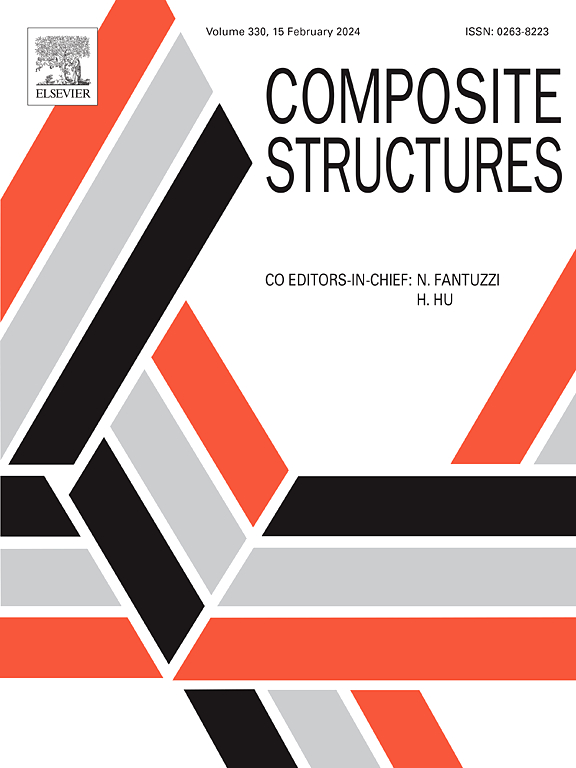Failure mechanism investigation of the adhesively bonded joints using Finite Element and Discrete Element methods
IF 6.3
2区 材料科学
Q1 MATERIALS SCIENCE, COMPOSITES
引用次数: 0
Abstract
Structural integrity is commonly defined by strength and durability of structure’s components. Adhesive joints have advantages over welding and bolted joints by less stress concentration, less weight and easier in manufacturing. In this study, numerical modelling analysis is employed to better understand fracture progression and its mechanism in adhesively bonded joints (lap shear joints) subjected to axial loading. Finite element method and discrete element method were used to predict strength and damage propagation of single lap joints. The study utilized Loctite EA 9497 epoxy as adhesive and three different adherends including polyphtalamide–polyphtalamide (PPA–PPA), aluminium–aluminium (AL–AL) and aluminium–polyphtalamide (AL–PPA) in the lap shear joints. The finite element model employed Cohesive Zone Model to examine joint strength, stress distributions along adhesive/adherend interface, and to perform scalar stiffness degradation analysis. The finite element model revealed that the adhesive damage takes place at the interface adjacent to the adherend with lower material stiffness. In addition, validation using load–displacement curves and comparison with experimental data demonstrated good agreement. Subsequently, discrete element model coupled with the Johnson–Kendall–Roberts (JKR) cohesion model was employed to adapted failure progression based on discrete particle interactions. The developed model was verified and compared with experimental results. Using the innovative discrete element method coupled with the JKR cohesion model, the bond number per particle parameter served as a material failure indicator. Analysis from the discrete element approach revealed that failure consistently takes place at the adhesive/adherend interface, irrespective of the adherend type. These study findings provide insights into investigating failure mechanisms in adhesively bonded joints at both macro- and micro-scales.
使用有限元和离散元方法研究粘合剂粘接接头的失效机理
结构完整性通常是指结构部件的强度和耐用性。与焊接和螺栓连接相比,粘合连接具有应力集中小、重量轻和易于制造等优点。本研究采用了数值建模分析方法,以更好地了解承受轴向载荷的粘接接头(搭接剪切接头)的断裂进展及其机理。研究采用有限元法和离散元法来预测单搭接接头的强度和损伤扩展。研究使用乐泰 EA 9497 环氧树脂作为粘合剂,并在搭接剪切接头中使用了三种不同的粘合剂,包括聚酞胺-聚酞胺 (PPA-PPA)、铝-铝 (AL-AL) 和铝-聚酞胺 (AL-PPA)。有限元模型采用粘合区模型来检验接头强度、沿粘合剂/外胶界面的应力分布,并进行标量刚度退化分析。有限元模型显示,粘合剂损坏发生在材料刚度较低的毗邻粘合剂的界面上。此外,利用载荷-位移曲线进行验证,并与实验数据进行比较,结果表明两者吻合良好。随后,离散元素模型与约翰逊-肯德尔-罗伯茨(Johnson-Kendall-Roberts,JKR)内聚力模型相结合,在离散粒子相互作用的基础上对破坏进程进行了调整。开发的模型与实验结果进行了验证和比较。利用创新的离散元素方法和 JKR 内聚力模型,每个颗粒的结合数参数可作为材料失效指标。离散元素方法的分析表明,无论粘合剂类型如何,失效始终发生在粘合剂/粘合剂界面。这些研究结果为研究宏观和微观尺度上粘合剂粘接接头的失效机制提供了启示。
本文章由计算机程序翻译,如有差异,请以英文原文为准。
求助全文
约1分钟内获得全文
求助全文
来源期刊

Composite Structures
工程技术-材料科学:复合
CiteScore
12.00
自引率
12.70%
发文量
1246
审稿时长
78 days
期刊介绍:
The past few decades have seen outstanding advances in the use of composite materials in structural applications. There can be little doubt that, within engineering circles, composites have revolutionised traditional design concepts and made possible an unparalleled range of new and exciting possibilities as viable materials for construction. Composite Structures, an International Journal, disseminates knowledge between users, manufacturers, designers and researchers involved in structures or structural components manufactured using composite materials.
The journal publishes papers which contribute to knowledge in the use of composite materials in engineering structures. Papers deal with design, research and development studies, experimental investigations, theoretical analysis and fabrication techniques relevant to the application of composites in load-bearing components for assemblies, ranging from individual components such as plates and shells to complete composite structures.
 求助内容:
求助内容: 应助结果提醒方式:
应助结果提醒方式:


